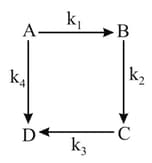Embibe Experts Solutions for Chapter: Chemical Kinetics, Exercise 5: Exercise-5
Embibe Experts Chemistry Solutions for Exercise - Embibe Experts Solutions for Chapter: Chemical Kinetics, Exercise 5: Exercise-5
Attempt the free practice questions on Chapter 10: Chemical Kinetics, Exercise 5: Exercise-5 with hints and solutions to strengthen your understanding. Alpha Question Bank for Engineering: Chemistry solutions are prepared by Experienced Embibe Experts.
Questions from Embibe Experts Solutions for Chapter: Chemical Kinetics, Exercise 5: Exercise-5 with Hints & Solutions
For a gaseous reaction products, the half-life of the first order decomposition at is minutes and the energy of activation is What fraction of molecules of at have sufficient energy to give the products?
At some temperature, the rate constant for the decomposition of on a gold surface is
What is the order of the reaction? How long will it take for the concentration of to drop from .
A certain reaction the first order with respect to each reactant Determine the final concentration of after if the initial concentration of was and that of was
For the complex,
Hence, ratio of rate constants of the forward and backward reaction is:
Consider the elementary reaction sequence shown in figure. Which of the following equation correct?

is a first order reaction,
| Time | ||
| Moles of reagent |
Reaction progress is measure with the help of titration of reagent If all and reacted with reagent and have factors [ factors; eq.wt ] in the ratio of with the reagent. The in terms of is:
For is characterised by:
Decomposition of is a first-order reaction. A solution of labeled as volumes was left open. Due to this, some is decomposed. To determine the new volume strength after hours, this solution was diluted to of this diluted solution was titrated against of solution under acidic conditions. Calculate the rate constant for the decomposition of in Report your answer as .
